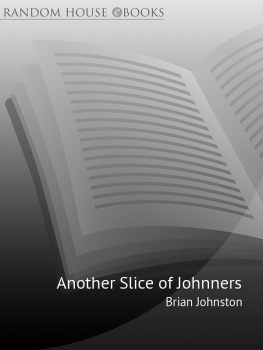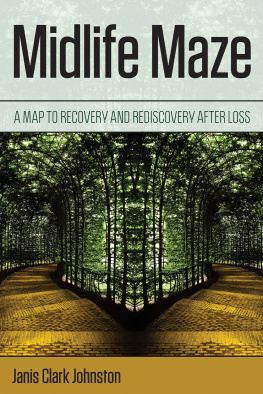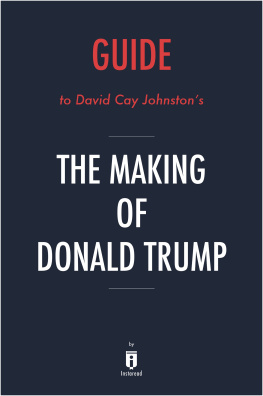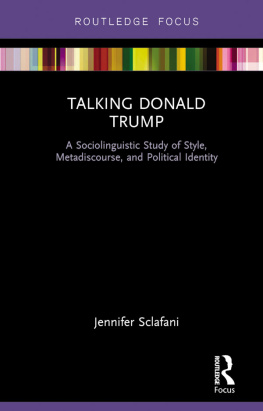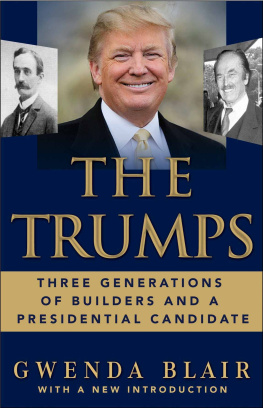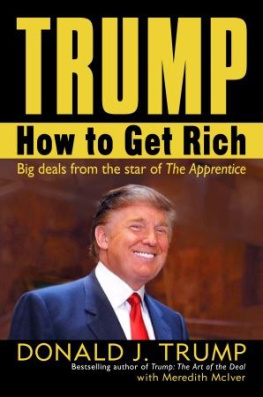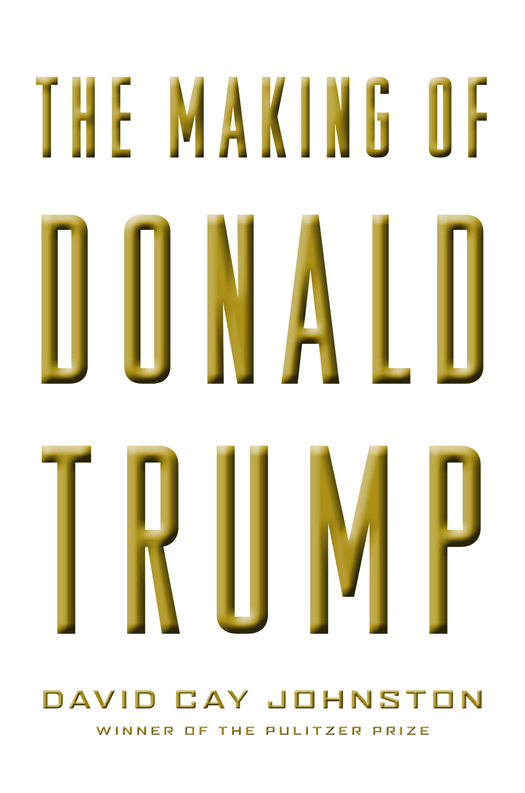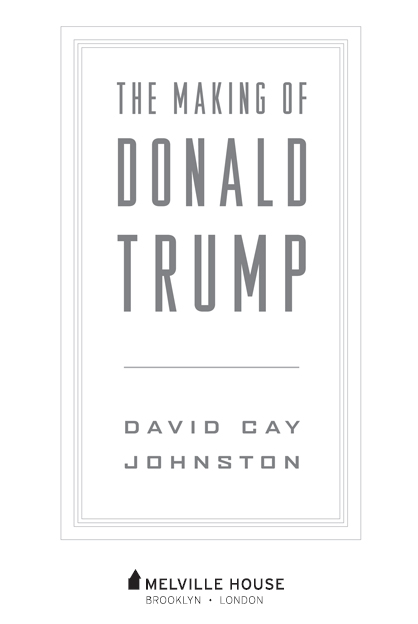THE MAKING OF DONALD TRUMP
Copyright 2016 by David Cay Johnston
First Melville House Printing: August 2016
Old Man Trump. Words by Woody Guthrie, music by Ryan Harvey.
Woody Guthrie Publications, Inc. (BMI) & Ryan Harvey (ASCAP).
All rights reserved. Used by permission.
Melville House Publishing
46 John Street
Brooklyn, NY 11201
and
8 Blackstock Mews
Islington
London N4 2BT
mhpbooks.comfacebook.com/mhpbooks@melvillehouse
Ebook ISBN: 978-1-61219-633-6
Design by Fritz Metsch
v3.1
For
Gene Roberts and Glenn Kramon, editors
and
John Wasserburger, teacher
CONTENTS
INTRODUCTION
W hen Donald Trump rode down the Trump Tower lobby escalator live on national television in June 2015 to announce his campaign for president, nearly every journalist treated his candidacy as a vanity project. Not me.
I have been an investigative reporter since I was eighteen years old. Ive been digging up facts, getting laws changed, and generally making a lot of trouble reporting for the San Jose Mercury, the Detroit Free Press, the Los Angeles Times, The Philadelphia Inquirer, and finally for The New York Times.
From the start, I acted on my own authority in deciding what to report. I was a newsroom rogue who got away with it because my stories engaged readers and got big results: a broadcast chain forced off the air for news manipulations; an innocent man saved from life in prison after I confronted the real killer; Jack Welch giving up his retirement perks; political spying and crimes by the Los Angeles Police Department revealed, along with foreign agents secretly interfering in American politics. While at my last paper, I won a Pulitzer Prize for exposing so many tax dodges and loopholes that a prominent tax law professor called me the de facto chief tax enforcement officer of the United States.
In 1987, I got interested in casinos after the Supreme Court ruled that Native Americans had a right to own them. I was sure it would lead to the spread of casinos across the countrycasinos run mostly by corporate America. For the only time in my life, I applied for a job. The Philadelphia Inquirer liked my idea: in June 1988, I moved to Atlantic City.
A few days later, I met Donald Trump.
I sized him up as a modern P. T. Barnum selling tickets to a modern variation of the Feejee Mermaid, one of the panoply of Barnums famous fakes that people decided were worth a bit of their money. Trump was full of himself. I quickly learned from others in town that he knew next to nothing about the casino industry, including the rules of the games. That would turn out to be important, as explained in two chapters near the end of this book.
In the nearly thirty years since then, I have followed Trump intensely; Ive paid close attention to his business dealings and Ive interviewed him multiple times. In 1990, I broke the story that, instead of being worth billions, as hed claimed, Trump actually had a negative net worth and escaped a chaotic collapse into personal bankruptcy only when the government took his side over the banks, as you will read.
Before technology allowed me to digitize files, I built up a vast trove of Trump documents, as investigative reporters often do with subjects that interest them. I had so many Bankers Boxes of files on Trump and other prominent AmericansBarron Hilton, Jack Welch, and Los Angeles police chief Daryl Gates among themthat for years I rented two storage lockers just to hold them all.
So when Trump announced his bid for the Republican nomination for the 2016 election, I knew it was for real. Id spent decades reporting on him and I had kept my files. In addition, reporter Wayne Barrett had generously shared his.
First, I knew that Trump has been talking about the presidency since 1985. In 1988, he proposed himself as the running mate of the first President George Bush, a job that went to Senator Dan Quayle. In July of the same year, I watched him arrive in Atlantic City on his yacht, the Trump Princess, where cheering crowds greeted him. A phalanx of teenage girls, jumping up and down, squealed with delight as if they had just seen their favorite rock star. As Trump and his then wife, Ivana, took an escalator up into his Trumps Castle Casino, a crowd cheered him on. One man shouted loudly, Be our president, Donald!
I also watched Trump run in 2000 on the ticket for the Reform Party, a fringe group with members in the tens of thousands (as opposed to the millions who call themselves Democrats or Republicans). It was during that brief campaign that Trump declared he would become the first person to run for president and make a profit. He said he had a million-dollar deal to give ten speeches at motivational speaking events hosted by Tony Robbins. He coordinated his campaign appearances around them so the campaign would pay for the use of his Boeing 727 jet. It was classic Trump, seeing profit in everything, even politics. Few people knew about it.
For the 2016 run as well, a large share of Trumps campaign money has been spent paying himself for the use of his Boeing 757, his smaller jet, his helicopter, his Trump Tower office space, and other services supplied by Trump businesses. By law, Trump must pay charter rates for his aircraft and market prices for services from his other businesses. This anticorruption law was designed to prevent vendors from underpricing services to win political favorsa legacy of a time when no one imagined that a man of Trumps presumed immense wealth would buy campaign services from himself. In 2016, the law ensures that Trump makes a profit from his campaign.
Trump again declared his candidacy in 2012. He was treated as a serious contender by just about everyone except Lawrence ODonnell of MSNBC and me. Separately, ODonnell and I both came to the conclusion that Trumps campaign then had a purpose other than moving to 1600 Pennsylvania Avenue. His real goal, we surmised, was a more lucrative contract with the NBC television network for his aging Celebrity Apprentice show, where his trademark line was Youre fired.
Indeed, when Trump dropped out, he said, in effect, that as much as the country needed him in the White House, his show needed him more. Based on that, journalists concluded his campaign had been a strange joke. As such, they gave little regard to his announcement for the 2016 election.
But this time things were different. Trumps ratings were in decline. His show was at risk of being canceled. To Trump, a man who reads the New York tabloids religiously, I knew that just about the worst fate he could imagine for himself, short of death, would be waking up to these Daily News and Post covers: NBC to Trump: Youre Fired.
As soon as Trump announced in 2015, I immediately set out to report what the mainstream news media were not. I wrote an early piece that posed twenty-one questions I thought reporters should ask on the campaign trail. Not one of them did. Late in the primaries, Senator Marco Rubio brought up my question about Trump University and Senator Ted Cruz posed my question about Trumps dealings with the Genovese and Gambino crime families, matters explored in this book. I will always wonder what might have happened had journalists and some of the sixteen candidates vying with Trump for the Republican nomination started asking my questions months earlier.




